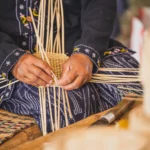Introduction
DIY projects and crafts are among the oldest and most popular forms of art. One art form has survived decades in a fast, convenient, and technological world. Artisans have always been original and smart. Frayed histories link past and present. See “The History of Crafts and Do-It-Yourself Projects.”
The Origins of Crafting
Civilization began with handcrafting. Our ancestors made tools, clothing, and homes from natural materials. These crafts helped them thrive in difficult circumstances. While working, they unwittingly set the groundwork for future creativity and precision. This shows longevity and ingenuity.
The Birth of Artisan Guilds
Amazingly, artists formed associations as society diversified. Artists and craftspeople who valued their skills founded these societies. They mostly maintained and transferred historical knowledge for future use. These communities emerged during the crucial Middle Ages commerce era.
Weavers weave beautiful fabrics, blacksmiths shape metal, and potters create usable clay things. Each group added colors and patterns to the weaving like quilt threads. History was changed forever.
The Renaissance Era
Cultural revival, or Renaissance, resurrected crafts. This comeback was made possible by printing breakthroughs that simplified craft knowledge and availability. This was da Vinci and Michelangelo’s peak. Renaissance masters were multidisciplinary. Paintings, sculptures, structures, and innovative designs shaped art and craft history.
The Industrial Revolution and Its Impact
The Impact of Mass Production
The Industrial Revolution transformed crafts and DIY. Mass manufacturing made items cheaper and more accessible but also harmed artistry.
Skilled craftspeople competed with manufacturers who produced goods faster and cheaper. Due to their inability to adapt to the Industrial Revolution, traditional crafts declined.
The Arts and Crafts Movement
After industrialization, the Arts and Crafts Movement began in the late 19th Century. William Morris led this campaign to promote contemporary craftsmanship and handcrafted items.
Quality, honesty, and maker-object relationship were stressed in the Arts and Crafts Movement. It revived traditional crafts and fostered the DIY movement.
The Birth of DIY Culture
During the Industrial Revolution, the idea of “do-it-yourself” began to take shape. When new tools and materials became available, people started thinking about how to make and customize their things.
People who were part of the DIY culture were urged to be proud of their work and learn new skills. It also encouraged people to be independent and able to take care of themselves, which are ideals that DIY fans still hold dear today.
The Arts and Crafts Movement
Because mass industrialization made individuals feel inferior and distant, the Arts & Crafts Movement began. This William Morris and John Ruskin movement stressed artistry and quality. Quality was more important than quantity; handmade things were beautiful and honest.
The Arts and Crafts Movement changed the view of tech-tired youth on making things. They considered it art, not a craft. This style revitalized artistry and raised its value by emphasizing the human touch.
DIY During the 20th Century
DIY projects proliferated in the 1900s as centurions sought control. Many manufactured items for their crops, homes, and personal use. DIY culture featured intricate woodworking, relaxing knitting, altering a house, and making unique daily products. People were more independent and creative, drawing DIYers of all kinds.
The Digital Age and Crafting
The internet transformed DIY in the late 20th Century. Online organizations, active forums, and Centuryyess video tutorials helped people learn new crafts skills, fueling this massive transformation. People of all ages can produce, and the internet lets people share ideas and practices.
Crafters worldwide shared knowledge and connected, fostering creativity. The internet DIY revolution makes creative experiences more straightforward and accessible, revolutionizing and creating history.
The Rise of Maker Culture
The interesting 21st-century maker movement mixes modern technology with handiwork. Due to this tendency, 3D printer and laser cutter maker spaces are brainstorming places. Because people are encouraged to create and build, art and technology merge. Creativity and new ideas make this history-making age interesting. Ancient talents and current technologies offer various choices.
Crafting in Modern Times
In today’s climate, handicrafts and do-it-yourself projects are more popular than ever. Many people use their spare time to craft as a means of self-expression and recreation. Making is still regarded as a very valuable pastime, whether it refers to the manufacturing of homemade candles, bespoke furniture, or one-of-a-kind presents.
The Benefits of Crafts and DIY Projects
Personal Fulfillment and Mental Well-being
Crafts and DIY projects might bring you a lot of joy and satisfaction. Making something by hand might help your mental health and reduce worry.
Crafting may boost their confidence and sense of self-worth as people learn new skills and see their work come together. When you finish something, you might want to start something new.
Building Community and Connections
Crafts and DIY projects build community. People may share their talent and learn from one another via local craft fairs, internet forums, and social media groups.
These contacts may lead to lifelong friendships, partnerships, mentoring, and support. Crafter and DIYer friendships are fulfilling and provide a feeling of belonging.
Economic and Environmental Benefits
Crafts and DIY projects provide economic, environmental, and social advantages. By making their own, people may save money and minimize their dependence on mass-produced goods.
DIY projects typically employ recycled materials, boosting sustainability and decreasing waste. Many contemporary craftspeople share this interest in environmental responsibility and want to improve the world.
Conclusion
Finally, crafts and DIY show ingenuity and adaptability. From the beginning of civilization until today, it shows our ability to build and invent. Craftsmanship survived the Industrial Revolution and mass production thanks to the Arts & Crafts Movement.
DIY initiatives for self-expression were prominent in the 20th century. Internet access in the late 20th century made crafts more accessible and allowed iCenturyals to meet globally. Modern makers combine technology and custom. Crafting shows creativity and resourcefulness. It honors past and present creativity and self-expression.

















